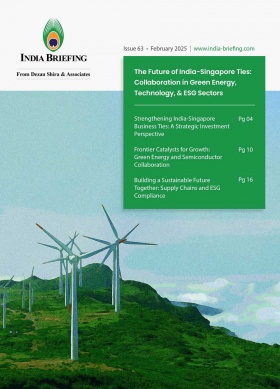India’s ECMS 2025: Application Window Opens May 1 – Incentives and Eligibility for Manufacturers
India has launched the Electronics Component Manufacturing Scheme (ECMS), with applications opening on May 1, 2025. The incentive distribution will be carried out by the central government on a “first-come, first-served” model.
We provide a comprehensive overview of the scheme guidelines, the components covered, eligibility criteria, and possible outcomes of the initiative
On April 26, 2025, India launched guidelines and an online portal for the Electronics Component Manufacturing Scheme (ECMS). The INR 229.19 billion (US$2.7 billion) initiative, seen as a step toward bolstering electronics production in India, aims to attract large-scale investments, boost domestic manufacturing, and enhance the country’s integration into global value chains.
As per the announcement, the scheme is set to run from FY 2025–26 to FY 2031–32, including a one-year gestation period and will support the development of a comprehensive supply chain for electronics manufacturing. The initiative also seeks to increase domestic value addition and position Indian companies as key players in global electronics markets.
India attracts proposals worth INR 80 billion under ECMS
India has received investment proposals worth INR 75 billion (US$874.6 million) to INR 80 billion (US$932.92 million) under the ECMS, according to a report by Business Standard.
The report published on July 7, 2025, states that nearly 100 applications have been submitted by both domestic and international firms seeking to establish manufacturing operations across India. The Union Ministry for Electronics and Information Technology (MeitY) is reportedly evaluating these applications, and approvals are expected to be issued in phases beginning in late August or early September in 2025. Additionally, a project management agency is being finalized to support the scheme’s implementation and monitoring.
The ECMS will be implemented over a six-year period, with the application window having opened on May 1, 2025. The submission process remains ongoing.
As part of the eligibility criteria, applicants are required to clearly outline the expected employment generation from their proposed projects. The scheme is focused on catalyzing domestic manufacturing of key components such as printed circuit boards (PCBs), non-surface mount device (non-SMD) components, lithium-ion cells, and other critical electronic parts.
Application window for target segments
The scheme will begin accepting applications from May 1, 2025, via its online portal: www.ecms.meity.gov.in. To ensure prompt participation from interested manufacturers, the scheme adopts a first-come, first-served model for incentive distribution.
Interested stakeholders must note that the ECMS scheme is aimed at four target segments.
|
S. no. |
Target segments |
Application window |
|
A. |
Sub-assemblies 1. Display module sub-assembly 2. Camera module sub-assembly |
*Application window opens from May 1, 2025, for 3 months |
|
B. |
Bare components 3. Non-surface mount devices (non-SMD) passive components for electronic applications 4. Electro-mechanicals for electronic applications 5. Multi-layer Printed Circuit Board (PCB) 6. Li-ion cells for digital applications (excluding storage and mobility) Enclosures for mobile and IT hardware products and related devices 7. Enclosures for Mobile, IT Hardware products and related devices |
|
|
C. |
Selected bare components 8. High-density interconnect (HDI)/modified semi-additive process (MSAP)/ flexible PCB 9. SMD passive components |
|
|
D. |
Supply chain ecosystem and capital equipment for electronics manufacturing. 10. Parts/components used in manufacturing of sub-assembly (A) and bare components (B) & (C) 11. Capital goods used in electronics manufacturing including their sub-assemblies and components |
**Application window opens on May 1, 2025, for 2 years. |
Source: Gazette notification, Ministry of Electronics and Information Technology, GoI
*Application window for Segment A, B and C can be extended further. It may also be reopened for applications at anytime during its tenure based on the response from the industry and budget availability.
**Under target segment D, the applications received under the scheme shall be appraised on an ongoing basis and implementation shall proceed as per the approvals agreed under the scheme. The fiscal support shall be available for investment made within five years from the date of acknowledgement of the application.
Types of incentives offered under ECMS
The ECMS offers three types of financial incentives to support eligible companies. These are as follows:
- Turnover-linked incentive: This incentive is calculated as a percentage of the increase in sales (turnover) over a company’s base year. It applies only to sales of eligible products made in India and covered under the scheme.
The incentive rate varies by product, as prescribed by the central government in its official notification. To a company to avail this incentive, it must meet two criteria:
- A minimum level of increased sales.
- A minimum level of cumulative investment.
Additionally, 1 percent of the incentive rate is linked to employment creation.
If the company does not meet employment requirements, the total incentive will be reduced by 1 percent.
Under target segments A, B and C, if the applicant chooses to opt for turnover linked incentive, the first year for the purpose of incremental sales would be counted from April 1, 2025, to March 31, 2026. For those opting for a gestation period, this would be taken from April 1, 2026, to March 31, 2027. Further, the cumulative incremental investment shall be counted from the date of scheme notification
- Capex incentive: This incentive supports spending on eligible capital equipment and infrastructure used to manufacture the specified products in India. To receive it, companies must:
- Meet the minimum investment requirement.
- Have started commercial production.
In addition, of the total 25 percent capex incentive, 5 percent is tied to job creation. If a company fails to meet the employment threshold, the total incentive will be reduced by 5 percent.
- Hybrid incentive: This is a combination of both turnover-linked and capex incentives, tailored to support specific high-priority products under the scheme.
|
S. no. |
Target segments |
Cumulative investment (INR) |
*Turnover linked incentive (%) Year 1 to 6 |
Capex incentive (%) |
|
A |
Sub-assemblies |
|||
|
1 |
Display module sub-assembly |
2.5 billion (US$29.47 million) |
4/4/3/2/2/1 |
NA |
|
2 |
Camera module sub-assembly |
2.5 billion (US$29.47 million) |
5/4/4/3/2/2 |
NA |
|
B |
Bare components |
|||
|
3 |
Non-SMD passive components |
500 million (US$5.89 million) |
8/7/7/6/5/4 |
NA |
|
4 |
Electro-mechanicals |
500 million (US$5.89 million) |
8/7/7/6/5/4 |
NA |
|
5 |
Multi-layer PCB |
500 million (US$5.89 million) |
≤ 6 layers 6/6/5/5/4/4 ≥ 8 layers 10/8/7/6/5/5 |
NA
|
|
6 |
Li-ion Cells for digital application (excluding storage and mobility) |
5 billion (US$58.95 million) |
6/6/5/5/4/4 |
NA |
|
7 |
Enclosures for mobile, IT Hardware products and related devices |
5 billion (US$58.95 million) |
7/6/5/4/4/3 |
NA |
|
C |
Selected bare components |
|||
|
8 |
HDI/MSAP/flexible PCB |
10 billion (US$117.91 million) |
8/7/7/6/5/4 |
25 percent |
|
9 |
SMD passive components |
2.5 billion (US$29.47 million) |
5/5/4/4/3/3 |
25 percent |
|
D |
Supply chain ecosystem and capital equipment |
|||
|
10 |
Supply chain of sub-assemblies (A) & bare components (B) & (C) |
100 million (US$1.17 million) |
NA |
25 percent |
|
11 |
Capital goods used in electronics manufacturing including their sub-assemblies and components |
100 million (US$1.17 million) |
NA |
25 percent |
Source: Press Information Bureau
*These incentives are calculated as a percentage of the incremental turnover over a defined base year and are applicable for six financial years, subject to meeting investment and employment thresholds.
Eligibility and components coverage under ECMS
To qualify under the ECMS, applicants must meet the following requirements:
- Greenfield as well as brownfield investment for the target segment shall be eligible under the scheme.
- An applicant shall submit separate applications for each target segment products.
- An applicant making multiple applications for the same product covered under the target segment shall not be eligible.
- The qualifications of applicants shall be decided on consolidated global Electronics System Design and Manufacturing (ESDM) revenue or manufacturing revenue/technological and financial capability and shall be detailed in the scheme guidelines.
|
*List of Products Covered Under Certain Target Segments |
|
|
Target segments |
Products covered |
|
Non-SMD passive components |
Resistors, capacitors, ferrites, specialty ceramics, inductors, coils (including inductive coil), etc., for electronic applications |
|
Electro-mechanicals |
Speakers and microphones for ICT products, relays, switches, connectors, heat sinks, antenna, vibrator motors, oscillators, filters, actuators, crystals, sensors (non-semiconductors), transducers, etc., for electronic applications |
|
Supply chain of sub-assemblies & bare components |
Laminate, pre-peg, copper foil, separator, cathode material, anode material, electrolyte, polypropylene film, spray wire, lenses, protective film, glass cover, back light, contrast film, polarizer film, etc., for electronic applications |
*This is an illustrative list and is not a complete list of supply chains.
Expected outcomes: Larger investments, more job creation
The scheme aims to attract investments worth INR 593.5 billion (US$6.99 billion), generate production output of INR 4.56 trillion (US$53.77 billion), and create 91,600 direct jobs, along with substantial indirect employment opportunities across the electronics value chain.
Structured strategy for India’s electronic sector expansion
The Union Minister for Electronics and Information Technology (MeITY) Ashwini Vaishnaw noted that India initially focused on assembling finished goods, which account for 80 to 85 percent of the value chain, before advancing to module and component manufacturing. He claimed the sector is now transitioning toward producing base materials essential for component manufacturing.
Since 2015, India’s electronics production has grown fivefold, while exports have increased by more than six times. The export compound annual growth rate (CAGR) of electronics components has surpassed 20 percent, with production growth exceeding 17 percent, driven largely by robust performance in mobile phones, laptops, servers, and IT hardware.
Click here to know more on India’s Electronics Manufacturing: Challenges and Opportunities
Multi-sectoral support and quality enhancements
Vaishnaw emphasized that the ECMS scheme will support not only the electronics sector but also automotive, industrial, and power industries. He stressed the need for domestic companies to build in-house design capabilities and aim for “Six Sigma” quality benchmarks, warning that substandard performance will not be accommodated under the scheme.
Six Sigma is a structured approach to quality improvement that equips organizations with tools to enhance the efficiency and effectiveness of their processes.
Its primary objective is to minimize or eliminate variations in processes, products, and services that can cause defects or errors. A process functioning at the Six Sigma level is expected to produce no more than 3.4 defects per million opportunities, whereas a higher defect rate indicates a lower sigma level.
According to experts, following this benchmark contributes to fewer defects in manufactured goods, increased profitability, better employee engagement, higher customer satisfaction, and improved quality in both products and services.
India has outlined a strategic framework under ECMS, which includes a unique hybrid incentive structure. Unlike traditional models, ECMS links fiscal incentives to both turnover and capital expenditure. This approach is designed to drive employment generation, economic growth, and deeper industrial integration.
Conclusion
By targeting key components and sub-assemblies and offering a well-structured blend of fiscal incentives, the scheme is designed to plug critical gaps in the supply chain, reduce import dependency, and enhance domestic value addition.
Coupled with a clear implementation roadmap and sector-specific support, ECMS is expected to catalyze high-impact investments, drive innovation, and create robust employment opportunities across industries. With its strategic integration into global value chains and focus on quality and scale, India is poised to emerge not just as a manufacturing hub, but as a key player in shaping the future of global electronics.
(US$1 = INR 84.80)
(This article was originally published on April 30, 2025. It has been updated on July 8, 2025.)
About Us
India Briefing is one of five regional publications under the Asia Briefing brand. It is supported by Dezan Shira & Associates, a pan-Asia, multi-disciplinary professional services firm that assists foreign investors throughout Asia, including through offices in Delhi, Mumbai, and Bengaluru in India. Dezan Shira & Associates also maintains offices or has alliance partners assisting foreign investors in China, Hong Kong SAR, Vietnam, Indonesia, Singapore, Malaysia, Mongolia, Dubai (UAE), Japan, South Korea, Nepal, The Philippines, Sri Lanka, Thailand, Italy, Germany, Bangladesh, Australia, United States, and United Kingdom and Ireland.
For a complimentary subscription to India Briefing’s content products, please click here. For support with establishing a business in India or for assistance in analyzing and entering markets, please contact the firm at india@dezshira.com or visit our website at www.dezshira.com.
- Previous Article Hiring Employees in India: A 2025 Guide for Global Businesses
- Next Article Countdown to the End of Trump’s Tariff Pause: Where Does India Stand Now?








